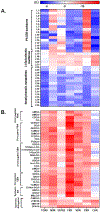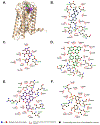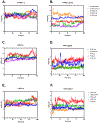Proanthocyanidin B2 derived metabolites may be ligands for bile acid receptors S1PR2, PXR and CAR: an in silico approach
- PMID: 37340688
- PMCID: PMC10730774
- DOI: 10.1080/07391102.2023.2224886
Proanthocyanidin B2 derived metabolites may be ligands for bile acid receptors S1PR2, PXR and CAR: an in silico approach
Abstract
Bile acids (BAs) act as signaling molecules via their interactions with various nuclear (FXR, VDR, PXR and CAR) and G-protein coupled (TGR5, M3R, S1PR2) BA receptors. Stimulation of these BA receptors influences several processes, including inflammatory responses and glucose and xenobiotic metabolism. BA profiles and BA receptor activity are deregulated in cardiometabolic diseases; however, dietary polyphenols were shown to alter BA profile and signaling in association with improved metabolic phenotypes. We previously reported that supplementing mice with a proanthocyanidin (PAC)-rich grape polyphenol (GP) extract attenuated symptoms of glucose intolerance in association with changes to BA profiles, BA receptor gene expression, and/or downstream markers of BA receptor activity. Exact mechanisms by which polyphenols modulate BA signaling are not known, but some hypotheses include modulation of the BA profile via changes to gut bacteria, or alteration of ligand-availability via BA sequestration. Herein, we used an in silico approach to investigate putative binding affinities of proanthocyanidin B2 (PACB2) and PACB2 metabolites to nuclear and G-protein coupled BA receptors. Molecular docking and dynamics simulations revealed that certain PACB2 metabolites had stable binding affinities to S1PR2, PXR and CAR, comparable to that of known natural and synthetic BA ligands. These findings suggest PACB2 metabolites may be novel ligands of S1PR2, CAR, and PXR receptors.Communicated by Ramaswamy H. Sarma.
Keywords: CAR; PXR; Polyphenols; S1PR2; bile acids; bile acids receptors; epicatechin; procyanidins.
Conflict of interest statement
Figures






Similar articles
-
Bile acid regulation of xenobiotic nuclear receptors on the expressions of orosomucoids in the liver.Am J Physiol Endocrinol Metab. 2025 Jun 1;328(6):E940-E951. doi: 10.1152/ajpendo.00417.2024. Epub 2025 May 6. Am J Physiol Endocrinol Metab. 2025. PMID: 40327538 Free PMC article.
-
Pharmacological Activation of PXR and CAR Downregulates Distinct Bile Acid-Metabolizing Intestinal Bacteria and Alters Bile Acid Homeostasis.Toxicol Sci. 2019 Mar 1;168(1):40-60. doi: 10.1093/toxsci/kfy271. Toxicol Sci. 2019. PMID: 30407581 Free PMC article.
-
The evolution of farnesoid X, vitamin D, and pregnane X receptors: insights from the green-spotted pufferfish (Tetraodon nigriviridis) and other non-mammalian species.BMC Biochem. 2011 Feb 3;12:5. doi: 10.1186/1471-2091-12-5. BMC Biochem. 2011. PMID: 21291553 Free PMC article.
-
Nuclear receptors CAR and PXR; therapeutic targets for cholestatic liver disease.Front Biosci (Landmark Ed). 2011 Jun 1;16(8):2988-3005. doi: 10.2741/3893. Front Biosci (Landmark Ed). 2011. PMID: 21622216 Review.
-
The xenobiotic receptors PXR and CAR in liver physiology, an update.Biochim Biophys Acta Mol Basis Dis. 2021 Jun 1;1867(6):166101. doi: 10.1016/j.bbadis.2021.166101. Epub 2021 Feb 15. Biochim Biophys Acta Mol Basis Dis. 2021. PMID: 33600998 Free PMC article. Review.
References
-
- Anhê FF, Nachbar RT, Varin TV, Trottier J, Dudonné S, Le Barz M, Feutry P, Pilon G, Barbier O, Desjardins Y, Roy D, & Marette A (2019). Treatment with camu camu (Myrciaria dubia) prevents obesity by altering the gut microbiota and increasing energy expenditure in diet-induced obese mice. Gut, 68(3), 453–464. 10.1136/gutjnl-2017-315565 - DOI - PubMed
-
- Bartik L, Whitfield GK, Kaczmarska M, Lowmiller CL, Moffet EW, Furmick JK, Hernandez Z, Haussler CA, Haussler MR, & Jurutka PW (2010). Curcumin: A novel nutritionally derived ligand of the vitamin D receptor with implications for colon cancer chemoprevention. The Journal of Nutritional Biochemistry, 21(12), 1153–1161. 10.1016/j.jnutbio.2009.09.012 - DOI - PMC - PubMed
MeSH terms
Substances
Grants and funding
LinkOut - more resources
Full Text Sources
Other Literature Sources
